Research News
-
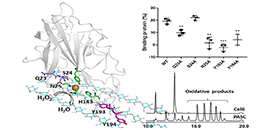 05 09, 2020Researchers Reveal Distinct Interaction of Lytic Polysaccharide Monooxygenase with CelluloseRecently, Prof. YIN Heng and Prof. LI Guohui from the Dalian Institute of Chemical Physics (DICP) of the Chinese Academy of Sciences discovered a novel interaction pattern of lytic polysaccharide monooxygenase (LPMO) with cellulose and determined the key residues involving in the process.
05 09, 2020Researchers Reveal Distinct Interaction of Lytic Polysaccharide Monooxygenase with CelluloseRecently, Prof. YIN Heng and Prof. LI Guohui from the Dalian Institute of Chemical Physics (DICP) of the Chinese Academy of Sciences discovered a novel interaction pattern of lytic polysaccharide monooxygenase (LPMO) with cellulose and determined the key residues involving in the process.
Recently, Prof. YIN Heng and Prof. LI Guohui from the Dalian Institute of Chemical Physics (DICP) of the Chinese Academy of Sciences discovered a novel interaction pattern of lytic polysaccharide monooxygenase (LPMO) with cellulose and determined the key residues involving in the process.
Their study, pulbished in J. Phys. Chem. Lett., sheds light on mechanisms of substrate preferences and regioselectivities of the enzyme.
Enzyme-substrate interaction is essential to elucidate the catalytic mechanism of enzymes and guide enzyme engineering. However, the interaction of the enzymes with their insoluble substrates in the two-phase interface has always been a tremendous problem due to the inapplicability of traditional methods.
The study of polysaccharide biodegradation catalyzed by LPMOs is one of these instances. LPMOs are a class of copper dependent metalloenzymes that oxidatively break down recalcitrant polymeric carbohydrates and provide more sites for glucoside hydrolase acting on.
Prof. YIN has been committed to mining novel LPMOs, identifying activity, and constructing light-driven LPMO activation. However, the mechanisms of the interactions between these enzymes and their substrates have yet to be fully elucidated.
In this study, the scientists employed computational and biochemical approaches and discovered that the enzymes could stably bind on the flat hydrophobic surface of cellulose via the interactions of the several key residues with two adjacent cellulose chains.
Combining with previous studies, they generated a hypothesis that the position and orientation of the bound enzymes on the surface of cellulose might be related to their regioselectivity.
Further study on the correlation of on the correlation of substrate binding and H2O2 accumulation suggested that the oxidation of the insoluble polysaccharides catalyzed by LPMOs was mainly driven by H2O2.
"These findings broadened our knowledge of the interaction between enzymes and insoluble substrates and deepened our understanding of the role that H2O2 plays in LPMO activity." said Prof. YIN.
The interactions of LPMO with cellulose and the key residues. (Image by ZHOU Haichuan)
This work was supported by the Chinese National Nature Science Foundation, CAS Youth Innovation Promotion Program, Liaoning Revitalization Talents Program and DICP Innovation Fund. (Text by ZHOU Haichuan) -
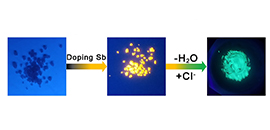 05 08, 2020Scientists Synthesize Undoped and Sb-doped Lead-free Zero-dimensional PerovskitesA research team led by HAN Keli from the Dalian Institute of Chemical Physics (DICP) of the Chinese Academy of Sciences successfully synthesized undoped and Sb-doped lead-free zero-dimensional (0D) perovskites.
05 08, 2020Scientists Synthesize Undoped and Sb-doped Lead-free Zero-dimensional PerovskitesA research team led by HAN Keli from the Dalian Institute of Chemical Physics (DICP) of the Chinese Academy of Sciences successfully synthesized undoped and Sb-doped lead-free zero-dimensional (0D) perovskites.
A research team led by HAN Keli from the Dalian Institute of Chemical Physics (DICP) of the Chinese Academy of Sciences synthesized undoped and Sb-doped lead-free zero-dimensional (0D) perovskites. Doping Sb3+ ions achieved a significant boost of the photoluminescence quantum yield (PLQY) from less than 2% to 85-95%.
They further investigated the stability and dynamics mechanism. Their findings were published in Angew. Chem. Int. Ed..
All-inorganic lead-free 0D perovskites have drawn wide attention due to non-toxicity, unique structures and optoelectronic properties.
Previous studies have focused on the stability of all-inorganic lead-free 0D perovskite, but the PLQY is still very low compared to organic-inorganic hybrid 0D perovskite. Therefore, it's needed to develop highly efficient and stable all-inorganic lead-free 0D perovskite and clarify its dynamics mechanism.
PL spectra and photographs under UV light of the 0D In-based perovskites. (Image by HAN Peigeng, LUO Cheng)
The scientists synthesized Sb-doped lead-free direct bandgap In-based 0D perovskites A2InCl5(H2O):Sb (A = Rb, Cs), which showed enhanced yellow photoluminescence (PL) emission. To study the effect of coordination H2O, A3InCl6:Sb (A = Rb, Cs) were also synthesized and showed bright green emission.
They further explored the effect of Sb3+ dopants and the origin of bright emission by ultrafast transient absorption techniques. In addition, Sb-doped 0D rubidium indium chloride perovskites exhibited excellent stability.
Their findings not only provided a way to design a set of new high-performance 0D lead-free perovskites, but also revealed the relationship between structure and PL properties.
This study was supported by the key research project of National Natural Science Foundation. (Text by HAN Peigeng) -
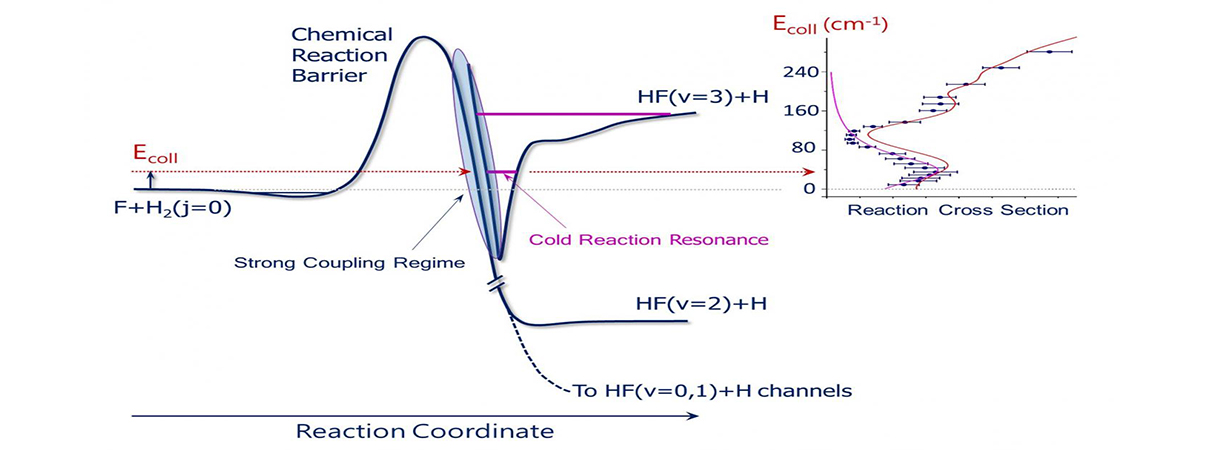 05 08, 2020Quantum Resonances near Absolute ZeroRecently, Prof. YANG Xueming from the Dalian Institute of Chemical Physics of the Chinese Academy of Sciences and Prof. YANG Tiangang from the Southern University of Science and Technology discussed significant advances in the study of quantum resonances in atomic and molecular collisions at near absolute zero temperature.
05 08, 2020Quantum Resonances near Absolute ZeroRecently, Prof. YANG Xueming from the Dalian Institute of Chemical Physics of the Chinese Academy of Sciences and Prof. YANG Tiangang from the Southern University of Science and Technology discussed significant advances in the study of quantum resonances in atomic and molecular collisions at near absolute zero temperature.
Recently, Prof. YANG Xueming from the Dalian Institute of Chemical Physics of the Chinese Academy of Sciences and Prof. YANG Tiangang from the Southern University of Science and Technology discussed significant advances in the study of quantum resonances in atomic and molecular collisions at near absolute zero temperature. Their article was published in Science on May 7.
The rules of quantum mechanics govern all atomic and molecular collision processes. Understanding the quantum nature of atomic and molecular collisions is essential for understanding energy transfer and chemical reaction processes, especially in the low collisional energy region, where quantum effect is the most prominent.
A remarkable feature of quantum nature in atomic and molecular collision is quantum scattering resonances, but probing them experimentally has been a great challenge due to the transient nature of these resonances.
The schematic shows quasi-bound quantum resonance state in the post barrier region, which is responsible for the enhanced reactivity in the F+H2 to HF+H reaction at temperature near absolute zero. (Image by YANG Tiangang)
This article introduced a quantum resonance study published in the same issue of Science by a research group from University of Nijmegen. By using the Stark decelerated molecular beam of NO(j=1/2f) and a cryogenic helium beam combined with high resolution velocity map imaging technique, De Jongh and coworkers observed resonances in the NO + He inelastic collisions at the temperature range of 0.3 to 12.3 K.
Accurate quantum dynamics calculations are in excellent agreement with experimental results. Particularly interesting is that the resonances can only be accurately described using a new NO-He potential energy surface (PES) at the CCSDT(Q) level, demonstrating the exceptionally high accuracy of the resonance picture developed for this benchmark inelastic collision system.
In addition to inelastic scattering processes, resonances in chemical reactive collisions in the low collision energy regime have been discussed. An important benchmark system for reaction resonances, discussed in the article, is the F+H2 to HF+H reaction, which is a major source of HF formation in interstellar clouds (ISC).
The F+H2 reaction is known to have a significant reaction barrier (629 cm-1), therefore its reactivity should be negligible at the temperature near absolute zero. Understanding the HF formation mechanism through this reaction at the cold temperatures is important, which can help to determine hydrogen column density in space.
With the improved molecular crossed beam apparatus, the F reaction and H2 have been studied as low as 14 K (9.8 cm-1) at the State Key Laboratory of Molecular Reaction Dynamics, DICP. A clear resonance peak at the collision energy of ~40 cm-1 has been discovered, which is found responsible for the enhanced reactivity near absolute zero temperature from the detailed dynamics analysis on an accurate PES. Because of the resonance enhanced quantum tunneling, this reaction should have unusually high reactivity at temperature below 1 K.
Further theoretical analysis indicated that if the contribution of the resonance-enhanced tunneling were removed from the reactivity, the reaction rate constant of F + H2 below 10 K would be reduced more than three orders of magnitude.
In this article, the authors pointed out that strong interaction between experiment and theory has been crucial in the study of transient collision resonances. The dynamics studies in atomic and molecular collisions are especially important to understanding energy transfer and chemical reaction processes that could have a wide impact on complicated systems, such as terrestrial and planetary atmospheres, interstellar clouds, gas-phase lasers, semiconductor processing, plasmas, and combustion processes. (Text by YANG Tiangang) -
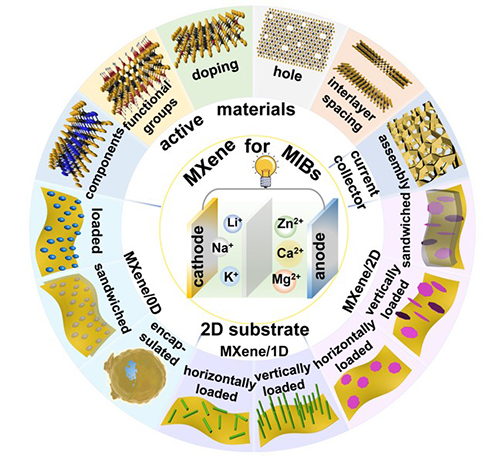 05 06, 2020The Progress and Promise of MXene based Metal Ion BatteriesScientists reviewed the recent progress of MXene based nanostructures for high performance metal ion batteries (MIBs), and share new insights on existing challenges and opportunities for designing high-performance MXene based electrodes for various MIBs. This review was published in Advanced Functional Materials.
05 06, 2020The Progress and Promise of MXene based Metal Ion BatteriesScientists reviewed the recent progress of MXene based nanostructures for high performance metal ion batteries (MIBs), and share new insights on existing challenges and opportunities for designing high-performance MXene based electrodes for various MIBs. This review was published in Advanced Functional Materials.
A research group led by Prof. WU Zhong-Shuai from the Dalian Institute of Chemical Physics (DICP) of the Chinese Academy of Sciences was invited to review the recent progress of MXene based nanostructures for high performance metal ion batteries (MIBs), and share new insights on existing challenges and opportunities for designing high-performance MXene based electrodes for various MIBs. This review was published in Advanced Functional Materials.
Schematic of MXene-based nanostructures for various MIBs. (Imaged by DONG Yanfeng)
MXenes, a large family of two dimensional transition metal carbides or carbonitrides, possessing exceptional conductivity in the crystal core and ample functional groups (e.g., -OH, -F, -O) on their surface, low energy barriers for metal ion diffusion, and large interlayer spaces for ion intercalation, are opening various intriguing opportunities to construct advanced MXene based nanostructures for different-type MIBs.
However, there is still lacking of a comprehensive and timely review of MXene based MIBs in both lithium ion batteries (LIBs) and non-lithium ion batteries (e.g., Na+, K+, Zn2+, Mg2+, Ca2+), through effective design principles for the construction of high-performance MXene based electrodes.
This review summarized the recent advances of MXene based nanostructures for high-performance MIBs from LIBs to non-LIBs, in which the unique roles of MXenes as active materials, conductive substrates, and even current collectors were highlighted.
Further, the loaded model, encapsulated model and sandwiched model were detailly clarified for MXene based hybrids with different dimensional (0D, 1D, and 2D) active materials for various MIBs, and each structural model was well exampled for different MIBs with special emphasis of synergistic effects and strong interaction interfaces between MXene and active materials.
Finally, the existing challenges and perspectives of MXene based nanostructures were briefly discussed for MIBs.
This work was supported by National Natural Science Foundation of China, National Key R&D Program of China, Natural Science Foundation of Liaoning Province, Dalian National Laboratory for Clean Energy of CAS, etc. (Text by DONG Yanfeng,HOU Xiaocheng) -
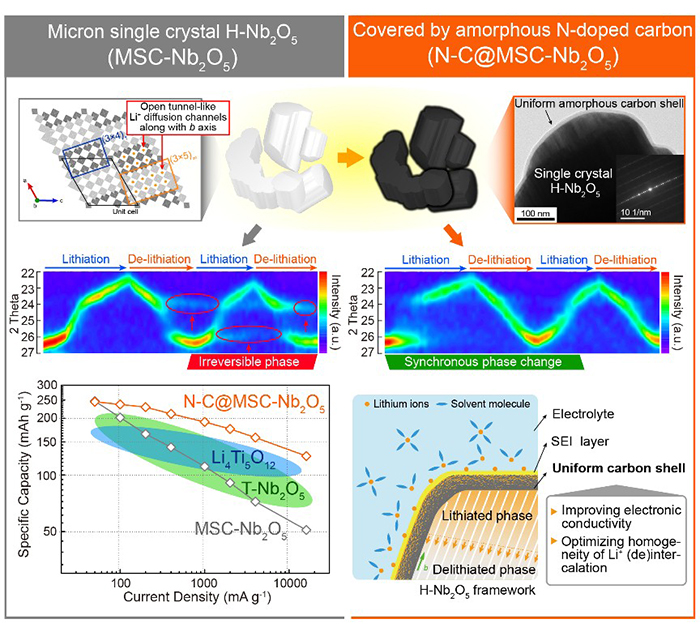 05 06, 2020A Performance Improvement Strategy for Lithium Ion Battery Anode via Optimizing the Homogeneity of Electron and Ion TransportScientists developed a high-rate anode material for lithium ion battery (LIB).The results were published in Advanced Materials.
05 06, 2020A Performance Improvement Strategy for Lithium Ion Battery Anode via Optimizing the Homogeneity of Electron and Ion TransportScientists developed a high-rate anode material for lithium ion battery (LIB).The results were published in Advanced Materials.
A research group led by Prof. LI Xianfeng, Prof. ZHANG Huamin and Prof. ZHANG Hongzhang from the Dalian Institute of Chemical Physics (DICP) of the Chinese Academy of Sciences (CAS), in collaboration with Prof. TANG Yongfu from Yanshan University, developed a high-rate anode material for lithium ion battery (LIB).The results were published in Advanced Materials.
Niobium pentoxide (Nb2O5) possesses a high specific capacity and fast Li storage kinetics in a safe operating potential window, which is suitable for high-rate battery systems. H-Nb2O5 exhibits the highest specific capacity of >250 mAh/g (1.0~3.0 V vs Li+/Li) among most configurations of Nb2O5.
However, the crystal structure of H-Nb2O5 would change during Li+ (de)intercalation, accompanied with the generation of certain irreversible and inactive phase. That is the main hinderance of H-Nb2O5 anodes in practical applications for LIBs.
Schematic of the performance improvement strategy for H-Nb2O5 as a high-rate anode material for LIBs. (Image by SONG Zihan)
The scientists in DICP found that optimizing homogeneity of electron and Li-ion transports surrounding the crystals was proposed to act a great role of improving the capacity and cycling life at high rates. An amorphous N-doped carbon layer is introduced on the micrometer single-crystal H-Nb2O5 particle (N-C@MSC-Nb2O5) to optimize the homogeneity of phase transition and to suppress the irreversible structure changes.
Therefore, N-C@MSC-Nb2O5 exhibits a long cycling life of over 1000 charge/discharge cycles at a high current density of 2000 mA/g, which is 10 times longer than that of pristine H-Nb2O5.
Moreover, N-C@MSC-Nb2O5 also shows a better rate performance than Li4Ti5O12-based and other Nb2O5-based anode materials. In addition, the inherent principle is further con?rmed via operando transmission electron microscopy (TEM) and X-ray diffraction (XRD).
This work was supported by Youth Innovation Promotion Association of CAS, National Natural Science Foundation of China, National Key Research and Development Project, Dalian National Laboratory for Clean Energy and Dalian Science and Technology Star Program. (Text by SONG Zihan) -
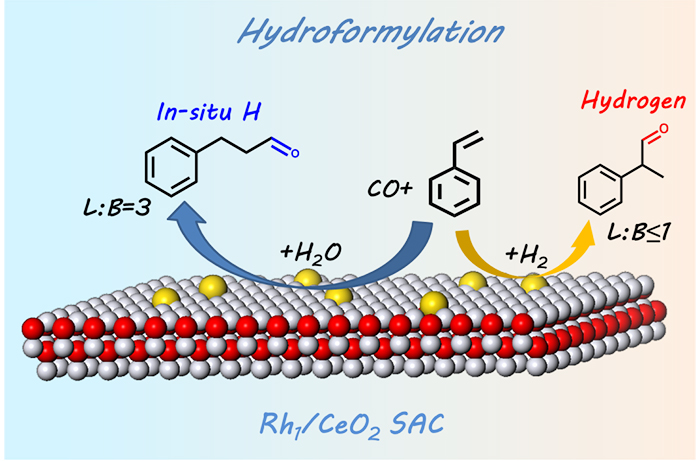 05 04, 2020DICP Researchers Find Coupling with Low-temperature Water-Gas Shift Reaction Will Change the Regioselectivity of Styrene HydroformylationScientists found a novel approach to selectively obtain linear aldehydes in hydroformylation of styrene and its derivatives by coupling with a water-gas shift reaction on Rh single-atom catalyst supported by CeO2 without using any ligands. The results were publised in Angew. Chem. Int. Ed.Recently, research group led by Prof. ZHANG Tao and Prof. QIAO Botao from the Dalian Institute of Chemical Physics (DICP) of the Chinese Academy of Sciences found a novel approach to selectively obtain linear aldehydes in hydroformylation of styrene and its derivatives by coupling with a water-gas shift reaction on Rh single-atom catalyst supported by CeO2 without using any ligands. The results were publised in Angew. Chem. Int. Ed. Hydroformylation of olefins is one of the most important homogeneously catalyzed industrial reactions for aldehyde synthesis. Various ligands are usually used to obtain desired linear aldehydes in aliphatic olefin hydroformylation. However, in aromatic hydroformylation it prefers to obtain branched aldehydes with common ligands, posing a grand challenge for the synthesis of linear products. To obtain high selectivity to linear aldehyde, steric hindrance ligands, such as triphosphoramidite and tetradentate phosphine, have to be used, which are generally followed by the problem of high cost and complex synthetic procedure. Therefore, the development of new approaches to manipulate the regioselectivity of styrene hydroformylation remains attractive but challenging in both fundamental study and practical applications. Detailed studies in this work revealed that the in situ H generated from the water-gas shift plays a critical role in determining the high regioselectivity to linear products. Besides, comparied with Rh single-atom catalyst, Rh homogeneous catalysts are much less active because of the inability to catalyse water-gas shift reaction, and Rh nanoparticle catalysts are mainly corresponding phenylpropanols rather than aldehydes, result in the decrease of chemoselectivity. The coupling of a traditionally homogeneous catalysis process with a heterogeneous catalysis reaction to tune product selectivity may provide a new avenue for the heterogenization of homogenous catalysis process. This work was supported by National Natural Science Foundation of China, National Key Projects for Fundamental Research and Development of China, Strategic Priority Research Program of the Chinese Academy of Sciences, DNL Cooperation Fund, CAS and LiaoNing Revitalization Talents Program. (Text and Imaged by LI Tianbo)
05 04, 2020DICP Researchers Find Coupling with Low-temperature Water-Gas Shift Reaction Will Change the Regioselectivity of Styrene HydroformylationScientists found a novel approach to selectively obtain linear aldehydes in hydroformylation of styrene and its derivatives by coupling with a water-gas shift reaction on Rh single-atom catalyst supported by CeO2 without using any ligands. The results were publised in Angew. Chem. Int. Ed.Recently, research group led by Prof. ZHANG Tao and Prof. QIAO Botao from the Dalian Institute of Chemical Physics (DICP) of the Chinese Academy of Sciences found a novel approach to selectively obtain linear aldehydes in hydroformylation of styrene and its derivatives by coupling with a water-gas shift reaction on Rh single-atom catalyst supported by CeO2 without using any ligands. The results were publised in Angew. Chem. Int. Ed. Hydroformylation of olefins is one of the most important homogeneously catalyzed industrial reactions for aldehyde synthesis. Various ligands are usually used to obtain desired linear aldehydes in aliphatic olefin hydroformylation. However, in aromatic hydroformylation it prefers to obtain branched aldehydes with common ligands, posing a grand challenge for the synthesis of linear products. To obtain high selectivity to linear aldehyde, steric hindrance ligands, such as triphosphoramidite and tetradentate phosphine, have to be used, which are generally followed by the problem of high cost and complex synthetic procedure. Therefore, the development of new approaches to manipulate the regioselectivity of styrene hydroformylation remains attractive but challenging in both fundamental study and practical applications. Detailed studies in this work revealed that the in situ H generated from the water-gas shift plays a critical role in determining the high regioselectivity to linear products. Besides, comparied with Rh single-atom catalyst, Rh homogeneous catalysts are much less active because of the inability to catalyse water-gas shift reaction, and Rh nanoparticle catalysts are mainly corresponding phenylpropanols rather than aldehydes, result in the decrease of chemoselectivity. The coupling of a traditionally homogeneous catalysis process with a heterogeneous catalysis reaction to tune product selectivity may provide a new avenue for the heterogenization of homogenous catalysis process. This work was supported by National Natural Science Foundation of China, National Key Projects for Fundamental Research and Development of China, Strategic Priority Research Program of the Chinese Academy of Sciences, DNL Cooperation Fund, CAS and LiaoNing Revitalization Talents Program. (Text and Imaged by LI Tianbo)